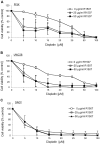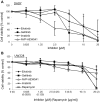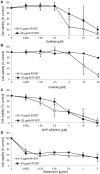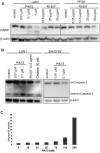Novel agents targeting the IGF-1R/PI3K pathway impair cell proliferation and survival in subsets of medulloblastoma and neuroblastoma
- PMID: 23056595
- PMCID: PMC3466180
- DOI: 10.1371/journal.pone.0047109
Novel agents targeting the IGF-1R/PI3K pathway impair cell proliferation and survival in subsets of medulloblastoma and neuroblastoma
Abstract
The receptor tyrosine kinase (RTK)/phosphoinositide 3-kinase (PI3K) pathway is fundamental for cancer cell proliferation and is known to be frequently altered and activated in neoplasia, including embryonal tumors. Based on the high frequency of alterations, targeting components of the PI3K signaling pathway is considered to be a promising therapeutic approach for cancer treatment. Here, we have investigated the potential of targeting the axis of the insulin-like growth factor-1 receptor (IGF-1R) and PI3K signaling in two common cancers of childhood: neuroblastoma, the most common extracranial tumor in children and medulloblastoma, the most frequent malignant childhood brain tumor. By treating neuroblastoma and medulloblastoma cells with R1507, a specific humanized monoclonal antibody against the IGF-1R, we could observe cell line-specific responses and in some cases a strong decrease in cell proliferation. In contrast, targeting the PI3K p110α with the specific inhibitor PIK75 resulted in broad anti-proliferative effects in a panel of neuro- and medulloblastoma cell lines. Additionally, sensitization to commonly used chemotherapeutic agents occurred in neuroblastoma cells upon treatment with R1507 or PIK75. Furthermore, by studying the expression and phosphorylation state of IGF-1R/PI3K downstream signaling targets we found down-regulated signaling pathway activation. In addition, apoptosis occurred in embryonal tumor cells after treatment with PIK75 or R1507. Together, our studies demonstrate the potential of targeting the IGF-1R/PI3K signaling axis in embryonal tumors. Hopefully, this knowledge will contribute to the development of urgently required new targeted therapies for embryonal tumors.
Conflict of interest statement
Figures









References
-
- Schwab M, Praml C, Amler LC (1996) Genomic instability in 1p and human malignancies. Genes Chromosomes Cancer 16: 211–229. - PubMed
-
- Schwab M, Alitalo K, Klempnauer KH, Varmus HE, Bishop JM, et al. (1983) Amplified DNA with limited homology to myc cellular oncogene is shared by human neuroblastoma cell lines and a neuroblastoma tumour. Nature 305: 245–248. - PubMed
-
- Plantaz D, Vandesompele J, Van Roy N, Lastowska M, Bown N, et al. (2001) Comparative genomic hybridization (CGH) analysis of stage 4 neuroblastoma reveals high frequency of 11q deletion in tumors lacking MYCN amplification. Int J Cancer 91: 680–686. - PubMed
-
- Van Roy N, Van Limbergen H, Vandesompele J, Van Gele M, Poppe B, et al. (2001) Combined M-FISH and CGH analysis allows comprehensive description of genetic alterations in neuroblastoma cell lines. Genes Chromosomes Cancer 32: 126–135. - PubMed
-
- Van Roy N, Jauch A, Van Gele M, Laureys G, Versteeg R, et al. (1997) Comparative genomic hybridization analysis of human neuroblastomas: detection of distal 1p deletions and further molecular genetic characterization of neuroblastoma cell lines. Cancer Genet Cytogenet 97: 135–142. - PubMed

